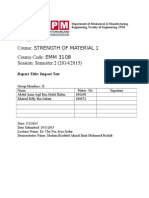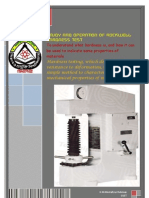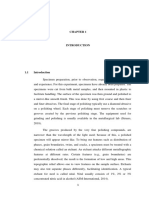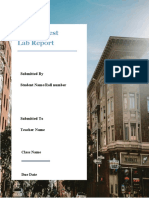Lab Report Assignment
Uploaded by
SethalaDeviVelusamyLab Report Assignment
Uploaded by
SethalaDeviVelusamyLab 3: Impact Testing
Date: March 17, 2009
Lab 3: Impact Testing
Department of Mechanical Engineering
By: Nickell Aktarian and Andrew Berry
March 17, 2009
-1-
Lab 3: Impact Testing
Date: March 17, 2009
Table of Contents
Summary
1 Introduction
2 Theory
2.1 Toughness
2.2 Impact Testing
2.3 Types of Fracture
3 Procedure
4 Results
4.1 Raw Data
4.2 Experimental Results
5 Discussion
5.1 Effect of Temperature on Cv
5.2 Relationship Between VHN and Cv
5.3 Nature of Fractures Obtained
5.4 Sources of Error
6 Conclusions
Recommendations
References
-2-
Lab 3: Impact Testing
Date: March 17, 2009
Summary
This lab report details the theory, observations and discussions of impact tests performed on
steel samples (carbon and mild). The temperature of the samples is varied, and the effect of the
temperature changes on the samples fracture energy and physical appearance of the fractures
are discussed. Mild steel is found to be more ductile than carbon steel, a fact that is also
supported by the Vickers hardness number being higher for mild steel then for carbon steel.
Also supported by the VHN is the increase in energy absorbed by the mild steel over the carbon
steel. Both samples exhibited more brittle fractures as temperatures of the samples decreased,
and more ductile fractures when the temperatures increased.
-3-
Lab 3: Impact Testing
Date: March 17, 2009
1 Introduction
Understanding when and how something will fail is fundamental to engineering. The behaviour
of mild steel and carbon steel under different temperature conditions are observed in this
experiment. The brittle nature of fractures that occur at low temperatures and ductile fractures at
high temperatures are compared to the amount of energy absorbed in the break. To observe
and understand these behaviours and how they are related to Vickers hardness, energy and
types of steel are the objectives of this experiment.
2 Theory
2.1 Toughness
The toughness of a material is defined as the amount of energy it can absorb during plastic
deformation prior to fracture. Toughness can be interpreted as the area under the curve of
strain-stress graph, and is expressed in units of energy per unit volume (see figure below).
Although hard alloy steels may have very high yield stresses, they are not very ductile and do
not possess the same ability to deform and dissipate applied energy as mild steels.
The toughness of a material may depend on several factors, such as rate of loading,
temperature, and characteristics acquired due to manufacturing methods such as heat-treating
and control of grain growth.
2.2 Impact Testing
The two most commonly performed impact tests are the Charpy and Izod tests. In both
cases, notched bar samples are contacted by a strategically positioned striker. In the Charpy
test, the sample is rested between two fixed supports located equidistant either side of the notch
and the striker contacts the face of the specimen obverse to the notch (see Figure 2, left). In the
Izod test, one end of the sample is clamped firmly such that the notch is aligned with the edge of
the clamp (Figure 2, right); the striker contacts the specimen on the notched face 22 mm above
the edge of the clamp.
The striker in this experiment consists of a heavy pendulum, as seen in Figure 3. Due to the
large impact velocity (about 4.5 m/s) and large mass of the pendulum, the sample is deformed at
a high strain rate of about 105 s-1, causing rapid fracture. The absorbed energy can be
calculated as the difference in potential energy of the pendulum at the top of its swing before and
after impact.
2.3 Types of Fracture
Depending on whether a material is ductile or brittle, different surface qualities may be visible
at the site of fracture. Hence, the shape of the fracture may be used to estimate the ductility of a
material: a fibrous surface may indicate failure due to shear forces (ductile failure), or a granular
cleavage may indicate failure from normal forces (brittle failure). The following figure shows
-4-
Lab 3: Impact Testing
Date: March 17, 2009
varying degrees of ductile and brittle fracture characteristics for A36 steel:
In a ductile failure, the shear forces cause a type of plastic deformation known as necking
(a decrease in cross-sectional area) and a slight elongation of the sample if a tensile force is
applied axially. Necking reduces the cross-sectional area until the normal stress at the thinnest
point has been concentrated to the point that it has exceeded the ultimate stress of the material
and the sample fails. The ductility of a fracture can be then quantified by computing the percent
shear lip:
% sheer lip =
ABxy
AB
1 00%
where A and B are the dimensions of the cross-section of the undeformed specimen, and x and
y are the cross-sectional dimensions of the fractured surface. Alternatively, the sample ductility
can be approximated by visually matching the fracture area to a reference chart:
As stated before, the toughness of a material can depend on several factors such as
temperature. The ductility of a material is closely related to the toughness of a material, as a
highly ductile material can plastically deform in order to dissipate the energy applied through
loading. Like toughness, the ductility of a material is dependent on temperature this is due to
the fact that molecules have more energy at high temperature and can be interact more freely
and form slip planes. Low temperature fractures patterns may appear brittle, whereas fractures
at higher temperatures will approach complete ductility.
3 Procedure
A Tinius Olsen testing machine consisting of a heavy pendulum and anvil-style sample
supports was used to perform Charpy tests on a number of samples. Two types of steel were
tested in this experiment: low carbon steel and an unidentified hard steel alloy. A sample of each
was fractured using the impact testing machine and the absorbed energy was recorded.
Samples of each steel heated in boiling water (100C) and cooled in dry ice (about -75C) were
then tested and the fracture patterns were observed.
4 Results
4.1 Raw Data
The absorbed energy from each test was read directly off the dial gauge on the apparatus;
the data is tabulated below:
-5-
Lab 3: Impact Testing
Temperature
Date: March 17, 2009
Low Carbon Steel
Alloy Steel
-75
20
100
16
37
2.5
3.5
3.5
4.2 Experimental Results
The energy absorbed (Cv) was plotted as a function of sample temperature:
5 Discussion
5.1 Effect of Temperature on Cv
From Figure 6, it can be seen that the Cv value for the low carbon steel increases
dramatically with temperature, whereas the Cv for the alloy steel increases only slightly. The
physical interpretation of this is that, although both steels are relatively brittle at low temperature,
the low carbon steel become highly ductile with an increase in temperature.
5.2 Relationship Between VHN and Cv
The Vickers hardness number (VHN) is a measure of a materials resistance to deformation,
particularly due to indentation. The published VHNs for low carbon steel vary between 10.0 and
64.0 [2]. The VHN values for low alloy steel vary between 36.0 and 848 [3] and range between
219 and 661 for medium alloy steels [4]. It is quite clear from this data that alloy steels are much
harder than low carbon steels.
Although both steel samples gave similar Cv values for the dry ice test, the low carbon steel
is radically more ductile at higher temperatures. It may be interesting to note that published
values from Charpy tests dont explicitly support or detract from this claim, as the Cv values of
6.00 to 250 ft-lb are expected for low carbon steels [2] and values of 11.1 to 250 ft-lb are
expected for low alloy steel [3].
Using the published VHNs of the samples and the experimentally determined Cv values, it
may be conjectured that VHN and Cv are inversely proportional that is, a hard material is not
-6-
Lab 3: Impact Testing
Date: March 17, 2009
as tough as a soft, ductile material.
5.3 Nature of Fractures Obtained
The types of fractures obtained for each temperature for each type of steel is pictured in
figures 7 and 8.
As the temperature in increased for the carbon steel the facture observed showed more and
more distortion, this observation supports the data recorded. More energy is needed to distort
the hotter, more ductile metal resulting in a higher energy reading from the pendulum.
The mild steel is very ductile at all temperatures tested, but did show more distortion in the
higher temperature sample compared to the coldest sample. The center of the lowest
temperature sample showed brittle fracture and therefore required less energy to break.
5.4 Sources of Error
Possible sources of error for this experiment include inhomogeneous or defective samples,
inconsistencies in the notches, and differences in testing conditions such as material
temperature and striking location. There is also significant room for error in the testing apparatus
due to bearing friction and air resistance of the pendulum, as well as a small amount of energy
lost during impact in the form of wave propagation.
Evidence of error in the data collected is given by the significant disparity between a typical
Cv value for mild steel at room temperature, about 60 ft-lb (given by lab manual), and the
experimentally determined Cv of 16 ft-lb. The percent error for these two values was computed
to be 73.3 % using the following formula:
6 Conclusions
Temperature can change the behaviour of steel from brittle to ductile with the addition of heat
or from ductile to brittle with the removal of heat. The amount of energy required to break a
ductile material is greater than for brittle material. Vickers Hardness is related to the energy
absorbed in the fracture of a material. The energy required to break the carbon steel was always
less than for the mild steel, supporting the evidence that carbon steel is more brittle and has a
lower VHN. When compared to accepted values and known characteristics, these hypotheses
are found to be correct. The increase in ductility with the addition of heat is also publicly
supported.
Recommendations
To improve the learning experience of this lab some calculations would be helpful. Calculating
the VHN or modulus of elasticity for the samples would be more interactive for students.
-7-
Lab 3: Impact Testing
Date: March 17, 2009
References
1. Anonymous, Mech 320 Solid Mechanics II: Lab #2, Combined Bending and Torsion Lab
Manual, online document, accessed March 6, 2009 [updated Spring 2009], available at:
http://www.me.uvic.ca/~mech320/MECH320-Lab2-CBT-Manual-2009.pdf
2. MatWeb materials database, Overview of materials for low carbon steel, online
document, accessed March 18, 2009, available at:
http://www.matweb.com/search/DataSheet.aspx?MatGUID=034970339dd14349a8297d
2c83134649
3. MatWeb materials database, Overview of materials for low alloy steel, online document,
accessed March 18, 2009, available at:
http://www.matweb.com/search/DataSheet.aspx?MatGUID=d1bdbccde4da4da4a9dbb8
918d783b29
4. MatWeb materials database, Overview of materials for medium alloy steel, online
document, accessed March 18, 2009, available at:
http://www.matweb.com/search/DataSheet.aspx?MatGUID=f7666326ceb3482f87a9f41ace1
d1fb0
-8-
You might also like
- Speakout Intermediate Units 3 & 4 Revision (Adapted From Achievement Tests) - ANSWER KEY0% (1)Speakout Intermediate Units 3 & 4 Revision (Adapted From Achievement Tests) - ANSWER KEY1 page
- S2 License Application Procedure (For GCQ Period)100% (1)S2 License Application Procedure (For GCQ Period)4 pages
- ME2113-2 Torsion of Circular Shafts Lab ReportNo ratings yetME2113-2 Torsion of Circular Shafts Lab Report6 pages
- Impact Toughness of Metallic Materials Lab ReportNo ratings yetImpact Toughness of Metallic Materials Lab Report5 pages
- Experiment No. 1 Impact Strength of A Material100% (1)Experiment No. 1 Impact Strength of A Material7 pages
- CE 212 Mechanics of Solids Sessional: Department of Civil EngineeringNo ratings yetCE 212 Mechanics of Solids Sessional: Department of Civil Engineering54 pages
- Observing Fracture Mechanics of The Supplied Specimen by Impact TestingNo ratings yetObserving Fracture Mechanics of The Supplied Specimen by Impact Testing11 pages
- EN22307194-Ranathunga R.A.S.S-Tensile Testing of Metals.No ratings yetEN22307194-Ranathunga R.A.S.S-Tensile Testing of Metals.16 pages
- EN123 Lab 2 Getting Acquainted With Analog Circuit Components Part 1 - Resistance, Capacitance & DiodeNo ratings yetEN123 Lab 2 Getting Acquainted With Analog Circuit Components Part 1 - Resistance, Capacitance & Diode6 pages
- Testing and Evaluation of Engineering Materials100% (1)Testing and Evaluation of Engineering Materials5 pages
- Identification of Ferrous and Non-Ferrous Metals CF1100: Materials & Processes Laboratory # 1No ratings yetIdentification of Ferrous and Non-Ferrous Metals CF1100: Materials & Processes Laboratory # 17 pages
- Charpy Impact Test: Strength-Of-Materials Lab (../index - HTML)No ratings yetCharpy Impact Test: Strength-Of-Materials Lab (../index - HTML)5 pages
- Characteristics of Worm and Wheel DriveNo ratings yetCharacteristics of Worm and Wheel Drive15 pages
- Izod Impact Test Aim:-: Apparatus Used:-Impact Testing Machine100% (2)Izod Impact Test Aim:-: Apparatus Used:-Impact Testing Machine4 pages
- University of Wollongong Lab Report Wear Test Report: Content0% (1)University of Wollongong Lab Report Wear Test Report: Content11 pages
- Tensile Testing of Ferrous and Non-Ferrous Alloy100% (1)Tensile Testing of Ferrous and Non-Ferrous Alloy7 pages
- Lab 1 Metallography Specimen Preparation - RepairNo ratings yetLab 1 Metallography Specimen Preparation - Repair6 pages
- Torsion Test Lab Report: Submitted by Student Name/Roll NumberNo ratings yetTorsion Test Lab Report: Submitted by Student Name/Roll Number12 pages
- Metallography:: Steps To Reveal Microstructures of A SpecimenNo ratings yetMetallography:: Steps To Reveal Microstructures of A Specimen7 pages
- Black Smithy Shop: 1-Supporting Tools: Leg ViceNo ratings yetBlack Smithy Shop: 1-Supporting Tools: Leg Vice10 pages
- Introduction and Literature Review Hardness100% (1)Introduction and Literature Review Hardness7 pages
- Lab 4 Mechanical Testing Tensile and Torsional TestingNo ratings yetLab 4 Mechanical Testing Tensile and Torsional Testing8 pages
- KJS 2343/KJS 3113 Industrial Measurement and InstrumentationNo ratings yetKJS 2343/KJS 3113 Industrial Measurement and Instrumentation46 pages
- Chapter 1 - Software Requirement FundamentalsNo ratings yetChapter 1 - Software Requirement Fundamentals23 pages
- Online Assignment Submission: Degree ProjectNo ratings yetOnline Assignment Submission: Degree Project99 pages
- Progress Report of Workshop: Department of Mechanical Engineering100% (2)Progress Report of Workshop: Department of Mechanical Engineering50 pages
- Academic Calendar 2014 For Undergraduate As at 15 Nov 2013No ratings yetAcademic Calendar 2014 For Undergraduate As at 15 Nov 20131 page
- Jadual Aktiviti Akademik Unit Rekod MAC 2014 21434No ratings yetJadual Aktiviti Akademik Unit Rekod MAC 2014 214341 page
- History: Sandal Found in US in 1938 in 18 Century, Industrial Era Begin Wide VarietyNo ratings yetHistory: Sandal Found in US in 1938 in 18 Century, Industrial Era Begin Wide Variety3 pages
- Car Navigation / CD Player: Service Manual Model: Lan8901Ekyn100% (1)Car Navigation / CD Player: Service Manual Model: Lan8901Ekyn87 pages
- Plan of Activities Araling Panlipunan 7: Subject TeacherNo ratings yetPlan of Activities Araling Panlipunan 7: Subject Teacher1 page
- VGA Controller Board: Support Single/double LVDS, With VGA Function, Support 1920 1200No ratings yetVGA Controller Board: Support Single/double LVDS, With VGA Function, Support 1920 12002 pages
- Cuestionario. Actividad Formativa 7. Guess The TensesNo ratings yetCuestionario. Actividad Formativa 7. Guess The Tenses7 pages
- export_Jacob Ehrreich_2025_04_12_08_18_53No ratings yetexport_Jacob Ehrreich_2025_04_12_08_18_5327 pages
- 2024accredited Resellers Contact Details Final100% (1)2024accredited Resellers Contact Details Final53 pages
- Top 5 ESG Factors for Coca-Cola Company and Financial ImpactNo ratings yetTop 5 ESG Factors for Coca-Cola Company and Financial Impact3 pages
- WEG CFW500 Programming Manual 10006739425 EnaaNo ratings yetWEG CFW500 Programming Manual 10006739425 Enaa268 pages
- Higher Unit 01a Check in Test - Calculations, Checking, RoundingNo ratings yetHigher Unit 01a Check in Test - Calculations, Checking, Rounding3 pages
- Pertemuan 08 - Tugas 8 - Autodesk Inventor Advanced ModelingNo ratings yetPertemuan 08 - Tugas 8 - Autodesk Inventor Advanced Modeling3 pages
- Number Systems, Operations, and Codes: by Taweesak ReungpeerakulNo ratings yetNumber Systems, Operations, and Codes: by Taweesak Reungpeerakul22 pages
- 657a7d6b-804f-4219-904f-5ec7ca780a8c (1)No ratings yet657a7d6b-804f-4219-904f-5ec7ca780a8c (1)194 pages







































































































